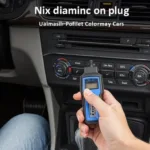An OBD2 port with no power can be frustrating. This comprehensive guide explores why your OBD2 port might be powerless and provides step-by-step solutions to get it working again. We’ll cover everything from simple checks to more advanced diagnostics, helping you pinpoint the problem and get back on the road.
After checking your car’s OBD2 port and finding no power, it can be concerning, especially if you’re trying to diagnose a check engine light. Don’t worry, this is a relatively common issue and often has a simple fix. This article will walk you through the most common causes of a powerless OBD2 port and provide you with effective troubleshooting steps. For instance, some OBD2 scanners require specific software, like the obd2 scanner lap top based software.
Common Causes of a Powerless OBD2 Port
Several factors can contribute to an OBD2 port not receiving power. Understanding these causes is the first step towards finding a solution. These range from blown fuses to more complex wiring issues.
- Blown Fuse: The most frequent culprit. A blown fuse in the circuit powering the OBD2 port is often the easiest fix.
- Wiring Problems: Damaged or corroded wiring can interrupt the power supply to the port.
- Faulty OBD2 Port: In rare cases, the port itself might be defective.
- DLC Location: Sometimes, the Data Link Connector (DLC), or OBD2 port, might be in an unexpected location, causing confusion.
- Ignition Issues: The OBD2 port might not receive power if the ignition isn’t in the correct position.
Troubleshooting Steps for an OBD2 Port with No Power
Here’s a systematic approach to diagnose and fix the issue:
- Check the Fuse: Locate the OBD2 port fuse in your car’s fuse box (refer to your owner’s manual). Inspect the fuse visually and test it with a multimeter for continuity. Replace if necessary.
- Inspect the Wiring: Visually check the wiring connected to the OBD2 port for any signs of damage, loose connections, or corrosion. Repair or replace as needed.
- Verify Ignition Position: Ensure your car’s ignition is in the “on” or “accessory” position. Some vehicles require the engine to be running for the OBD2 port to be powered. Sometimes, a simple plug-and-play device can resolve the issue, such as the obd2 plug and drive obdii.
- Test with a Multimeter: If the fuse and wiring appear intact, use a multimeter to test for voltage at the OBD2 port. This will confirm whether power is reaching the port.
- Consult a Professional: If you’ve exhausted all troubleshooting steps and the problem persists, it’s time to consult a qualified mechanic.
Why is My OBD2 Port Not Working?
This is a common question. A non-working OBD2 port can stem from various issues, including a blown fuse, damaged wiring, or a faulty port. Identifying the root cause is essential for effective troubleshooting. Using a dedicated OBD2 scanner can sometimes help diagnose the issue. Consider checking out the Ancel OBD2 Scanner AD310.
What if the Fuse is Good?
If the fuse is intact, the problem likely lies elsewhere. Check the wiring for damage or loose connections. A multimeter can be used to check for voltage at the OBD2 port.
How do I Test the OBD2 Port with a Multimeter?
Set the multimeter to measure DC voltage. Connect the black lead to a ground point in your car and the red lead to the appropriate pin on the OBD2 port (pin 16 for power).
Conclusion
A powerless OBD2 port can be a nuisance, but with the right approach, you can often diagnose and fix the issue yourself. By following these troubleshooting steps and understanding the common causes, you can get your OBD2 port back in working order and access valuable diagnostic information. Remember to always consult your car’s owner’s manual for specific instructions and safety precautions. If you encounter a specific error code, researching it can provide valuable insights, such as understanding the P0090 Mazda OBD2 code. If the problem persists, seek professional assistance.
FAQ
- Why is my OBD2 scanner not connecting? A powerless OBD2 port is a common reason for scanner connection issues.
- Where is the OBD2 port fuse located? Refer to your car’s owner’s manual for the exact location.
- Can I drive my car with a blown OBD2 port fuse? Yes, but you won’t be able to use an OBD2 scanner for diagnostics.
- How much does it cost to fix a powerless OBD2 port? The cost varies depending on the cause. A simple fuse replacement is inexpensive, while wiring repairs can be more costly.
- What if I can’t find the problem? Consult a qualified mechanic for professional diagnosis and repair.
- How can I prevent future OBD2 port power issues? Regular car maintenance and inspections can help prevent wiring problems and other potential issues.
- Is it safe to test the OBD2 port with a multimeter? Yes, as long as you follow proper safety precautions and consult your car’s owner’s manual.
Expert Insight:
- John Miller, Automotive Electrical Engineer: “A blown fuse is the most common cause of a powerless OBD2 port. Always start your troubleshooting by checking the fuse box.”
- Sarah Davis, Certified Mechanic: “Damaged wiring can also interrupt power to the OBD2 port. Inspect the wiring carefully for any signs of damage or corrosion.”
- David Lee, Automotive Diagnostic Specialist: “If you’re unsure about any step in the troubleshooting process, consult a qualified mechanic. They can diagnose the problem accurately and perform the necessary repairs.”
For further assistance with your car diagnostic needs, please contact us via WhatsApp: +1(641)206-8880, or Email: cardiagtechworkshop@gmail.com. We offer 24/7 customer support.


